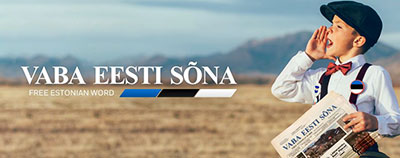Lisa Trei tells the story of her family and invites others to share their stories as part of an exhibition opening at the Vabamu Museum next year.
It’s been almost a year since I moved back to Estonia to attend Tallinn University and serve as a Fulbright Specialist at the Vabamu Museum of Occupations and Freedom.
I previously lived in Tallinn in the 1990s, and it’s been remarkable to return and experience the achievements of three decades of independence. The Soviet hangover is gone. The fact that a generation of citizens have grown up with no first-hand memory of communism is a testament to Estonia’s success as a democratic state. Witnessing the national resolve to remain sovereign in the face of intensifying hybrid warfare, as well as Estonia’s steadfast support for Ukraine makes me proud to make a small contribution to my family’s homeland.
After retiring last year from Stanford University, I applied to Tallinn University to pursue a master’s degree in Estonian Studies. I wanted to translate Unustatud merereisid (Forgotten Sea Journeys) by Jüri Vendla, a history book about the Estonian refugees who fled from Sweden in the late 1940s and sailed across the Atlantic in small boats to escape being sent back to Soviet-occupied Estonia. My late father, Alan Trei, had started writing a novel about one of the boats, the Erma, and his research is included in Vendla’s book.
When the master’s program was suddenly canceled, I learned about the U.S. government’s Fulbright Specialist program, which sends professionals to work at academic institutions abroad. Given Stanford’s long-time connection with Vabamu, the fellowship was a natural fit. In addition to advising on communications, I began developing a digital exhibit based on Unustatud merereisid that will launch this fall to coincide with the 80th anniversary of the Suur põgenemine (Great Flight).
A Saaremaa story
My return to Estonia brings full circle a journey begun by my grandparents, Alice and Peeter Trei, who emigrated from Saaremaa to America in the 1920s in search of greater opportunities. My father was born in New York City and, unlike most children of émigrés my age, I did not grow up hearing Estonian. To me, Estonia was a far-off, mystical land where people wore folk costumes and spoke an unintelligible language. It was only when our family visited Tallinn for the 1985 Laulupidu that I discovered Estonia was a real place. My grandmother bought me a Muhu costume so I could join my cousin’s choir in the parade and stand under the festival arch. This magical experience left a deep impression and inspired me to learn more about Estonia.
In 1990, Marju Lauristin spoke at Columbia University, where I had earned a master’s degree in journalism, and afterward, she invited me to teach “practical journalism” at the University of Tartu. By then I was an ambitious reporter eager to cover the crumbling Soviet empire for U.S. newspapers from Tallinn, not Moscow, where most foreign correspondents were based. In October 1990, I moved to Tartu to teach and started working for The Estonian Independent English-language weekly.
The revolutionary events of 1991 pushed the backwater Baltic States onto the front pages of newspapers around the world. For six years I covered the region for U.S. newspapers and magazines, including the Wall Street Journal. During that time, I acquired an Estonian passport and met my future husband.
In 1996, we moved to California, and I began working at Stanford. As our three daughters grew up, I became active in the San Francisco Estonian Society and joined the Estonian American National Council. In 2015, my two youngest girls attended a camp for children of Estonian heritage in Viljandimaa sponsored by the Integration Foundation. In 2017, a small group, including my daughter Kaia and myself, decided it would be fun to participate in the Laulupidu. We formed the San Francisco Community Choir and, after a lot of work, we were accepted. Kaia, to my delight, wore the Muhu costume my grandmother bought me 34 years earlier at the 2019 Song Festival. Now she and her sister Alise hope to sing at the 2025 Laulupidu with the San Francisco choir. I also look forward to participating as a member of Kalamaja Segakoor, which I joined last fall.
Share Your Family’s Story with Vabamu
With its extensive public outreach, tours, and educational curricula, Vabamu is so much more than a building filled with old artifacts. Its young and dynamic staff is developing a major new exhibition opening in 2025 called “Global Estonians” that will highlight the history of Estonian migration, eastwards and westwards, voluntary and forced, from the late 19th century to the present day. When Estonians move, they carry part of their homeland with them, and Vabamu wants to capture these stories.
For Estonians living overseas, either now or in the past, we need your help to make the exhibition a success. You are invited to send a photo to Vabamu https://nova.vabamu.ee/en/study-bites/global-estonians/ and describe in up to 100 words your idea of Global Estonia. Consider how you and your family, friends, home, and work represent what it means to be an Estonian. Vabamu wants to capture today’s stories as well as those from long ago. Submissions may be included in the exhibition, which everyone is invited to visit when “Global Estonians” opens in Tallinn next summer.
* By sharing your photo and story, you give Vabamu permission to include this information solely in the “Global Estonians” exhibition.
Üleilmsed eestlased: aita luua Vabamu uut näitust – Noorte Vabamu
https://nova.vabamu.ee/study-bites/uleilmsed-eestlased-uus-naitus-vabamus
https://nova.vabamu.ee/en/study-bites/global-estonians
Lisa Trei
Fulbright Specialist at Vabamu, Spring 2024
Estonian Studies, MA ’26, Tallinn University












